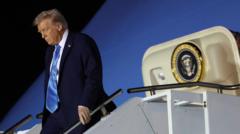The article delves into the intricate dynamics of the ceasefire talks, showcasing how pressure from multiple fronts ultimately forced a resolution between Israel and Hamas.
**Behind the Last-Minute Gaza Ceasefire Deal: An In-Depth Analysis**

**Behind the Last-Minute Gaza Ceasefire Deal: An In-Depth Analysis**
Negotiations stretched over months as key players converged in Doha, culminating in a historic agreement mere moments before a press conference.
The long-awaited ceasefire agreement between Israel and Hamas was finalized in an astonishingly close timing—just 10 minutes prior to a scheduled press conference for announcement. Negotiations had been ongoing for months, facilitated primarily through intermediaries from Qatar, Egypt, and the US, but the atmosphere of urgency intensified as key players convened under one roof in Doha. The tension was palpable as insiders revealed that the final discussions unfolded even as a podium was being set up for the formal announcement.
The ceasefire was structured around a framework first proposed by President Joe Biden in May 2023, incorporating a three-phase approach involving a ceasefire, release of hostages by Hamas in exchange for Palestinian prisoners, and a strategic withdrawal of Israeli forces from Gaza. Several sources have indicated that by mid-December, the dynamics shifted dramatically, pressuring Hamas which was already isolated and grappling with the loss of its leader, Yahya Sinwar, due to Israeli military actions.
A US official noted that this shift forced Hamas to reevaluate its strategy. Whereas previously, Hamas might have dictated terms, the group was now facing an urgent need for compromise following regional setbacks involving its allies, notably Hezbollah and the Assad regime in Syria. The intensity of the talks increased sharply when the Biden administration carried out direct engagements with Israeli Prime Minister Benjamin Netanyahu in December, setting the stage for more robust discussions regarding Gaza.
With the emergence of Donald Trump’s impending presidency, indications pointed towards an increase in pressure on both Hamas and the Israeli government. Despite initial optimism from Hamas officials about potential agreements, the negotiation process witnessed numerous hindrances. In December, disagreements over the lists of hostages led to substantial roadblocks, with both parties struggling to synchronize their demands.
However, breakthroughs came as negotiations continued, particularly focusing on proposals surrounding the release of prisoners and the conditions for Israeli troop withdrawals. By January 9, 2024, it was reported that 90% of the terms had been agreed upon, marking a critical turning point in the talks.
The final hours saw aggressive diplomacy, with Trump's envoy Steve Witkoff playing a pivotal role in pressuring Netanyahu to settle his reservations over the deal. His insistence on an immediate meeting—despite it being the sabbath—demonstrated the urgency under which the talks were taking place. Witkoff's presence, alongside Biden’s envoy, was instrumental in achieving a breakthrough that many officials claimed would not have been possible without the incoming Trump administration's involvement.
Even in the last days leading to the agreement, there were moments of tension, particularly around security protocols for the return of displaced individuals in Gaza. The negotiators faced stalemates, which they resolved only through timely interventions from Qatari and Egyptian mediators.
Ultimately, the dramatic finalization of the deal serves as a reflection of the intricate balancing act that took place among the involved parties, showcasing how diplomatic efforts can lead to peace, even under the most challenging circumstances. The announcement of the ceasefire marked a historic moment for both sides, with hopes of a renewed path towards stability.
The ceasefire was structured around a framework first proposed by President Joe Biden in May 2023, incorporating a three-phase approach involving a ceasefire, release of hostages by Hamas in exchange for Palestinian prisoners, and a strategic withdrawal of Israeli forces from Gaza. Several sources have indicated that by mid-December, the dynamics shifted dramatically, pressuring Hamas which was already isolated and grappling with the loss of its leader, Yahya Sinwar, due to Israeli military actions.
A US official noted that this shift forced Hamas to reevaluate its strategy. Whereas previously, Hamas might have dictated terms, the group was now facing an urgent need for compromise following regional setbacks involving its allies, notably Hezbollah and the Assad regime in Syria. The intensity of the talks increased sharply when the Biden administration carried out direct engagements with Israeli Prime Minister Benjamin Netanyahu in December, setting the stage for more robust discussions regarding Gaza.
With the emergence of Donald Trump’s impending presidency, indications pointed towards an increase in pressure on both Hamas and the Israeli government. Despite initial optimism from Hamas officials about potential agreements, the negotiation process witnessed numerous hindrances. In December, disagreements over the lists of hostages led to substantial roadblocks, with both parties struggling to synchronize their demands.
However, breakthroughs came as negotiations continued, particularly focusing on proposals surrounding the release of prisoners and the conditions for Israeli troop withdrawals. By January 9, 2024, it was reported that 90% of the terms had been agreed upon, marking a critical turning point in the talks.
The final hours saw aggressive diplomacy, with Trump's envoy Steve Witkoff playing a pivotal role in pressuring Netanyahu to settle his reservations over the deal. His insistence on an immediate meeting—despite it being the sabbath—demonstrated the urgency under which the talks were taking place. Witkoff's presence, alongside Biden’s envoy, was instrumental in achieving a breakthrough that many officials claimed would not have been possible without the incoming Trump administration's involvement.
Even in the last days leading to the agreement, there were moments of tension, particularly around security protocols for the return of displaced individuals in Gaza. The negotiators faced stalemates, which they resolved only through timely interventions from Qatari and Egyptian mediators.
Ultimately, the dramatic finalization of the deal serves as a reflection of the intricate balancing act that took place among the involved parties, showcasing how diplomatic efforts can lead to peace, even under the most challenging circumstances. The announcement of the ceasefire marked a historic moment for both sides, with hopes of a renewed path towards stability.























